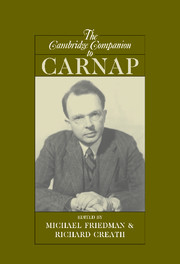Book contents
- Frontmatter
- Introduction: Carnap’s revolution in philosophy
- 1 Carnap’s intellectual development
- 2 Geometrical leitmotifs in Carnap’s early philosophy
- 3 Carnap and Frege
- 4 Carnap and Husserl
- 5 Carnap, Russell, and the external world
- 6 The Aufbau and the rejection of metaphysics
- 7 Carnap and the Vienna Circle: rational reconstructionism refined
- 8 Carnap and modern logic
- 9 Tolerance and logicism: logical syntax and the philosophy of mathematics
- 10 Carnap’s quest for analyticity: the Studies in Semantics
- 11 Carnap on the rational reconstruction of scientific theories
- 12 Carnap on probability and induction
- 13 Carnapian pragmatism
- 14 Quine’s challenge to Carnap
- Bibliography
- Index
9 - Tolerance and logicism: logical syntax and the philosophy of mathematics
Published online by Cambridge University Press: 28 April 2008
- Frontmatter
- Introduction: Carnap’s revolution in philosophy
- 1 Carnap’s intellectual development
- 2 Geometrical leitmotifs in Carnap’s early philosophy
- 3 Carnap and Frege
- 4 Carnap and Husserl
- 5 Carnap, Russell, and the external world
- 6 The Aufbau and the rejection of metaphysics
- 7 Carnap and the Vienna Circle: rational reconstructionism refined
- 8 Carnap and modern logic
- 9 Tolerance and logicism: logical syntax and the philosophy of mathematics
- 10 Carnap’s quest for analyticity: the Studies in Semantics
- 11 Carnap on the rational reconstruction of scientific theories
- 12 Carnap on probability and induction
- 13 Carnapian pragmatism
- 14 Quine’s challenge to Carnap
- Bibliography
- Index
Summary
The logical empiricism of the Vienna Circle presented itself as the reconciliation of a thoroughgoing empiricism as regards substantive knowledge with the certainty and necessity of mathematics. According to empiricism, sense experience is the only source of substantive knowledge of facts, but sense experience might always have been different from what it actually was. Moreover, anything we extrapolate from what we experience may be falsified by further experiences. Knowledge grounded in sense experience is thus knowledge of contingencies, and except perhaps for knowledge of what is immediately experienced (“Red here now”), it is revisable on the basis of further experiences. In contrast, knowledge of mathematics appears to be unrevisably certain substantive knowledge of necessary truths. The contingencies of our sense experience thus seem to afford no basis for knowledge of mathematics. In a word, empiricism must be false, because mathematics is substantive a priori knowledge.
The logical empiricist approach to this dilemma is to deny that knowledge of mathematics is substantive knowledge. The apriority and necessity of mathematics is the apriority and necessity of logic. Logic is in its turn grounded in tacit conventions for the use of certain symbols, symbols that do not themselves stand for anything, like the signs for negation and conjunction. As Hans Hahn put it:
[Logic] only deals with the way we talk about objects; logic first comes into being through language. And the certainty and universal validity of a proposition of logic . . . flows precisely from this, that it says nothing about any objects . . .We learn – by training, as I should like to put it – to assign the designation “red” to some of these objects, and we make an agreement to assign the designation “not red” to any others. On the basis of this agreement we can now state the following proposition with absolute certainty: None of these objects is assigned both the designation “red” and the designation “not red,” which is usually expressed briefly as follows: No object is both red and not red.”
(Hahn, 1933/1987, 29)- Type
- Chapter
- Information
- The Cambridge Companion to Carnap , pp. 200 - 225Publisher: Cambridge University PressPrint publication year: 2007
- 11
- Cited by



